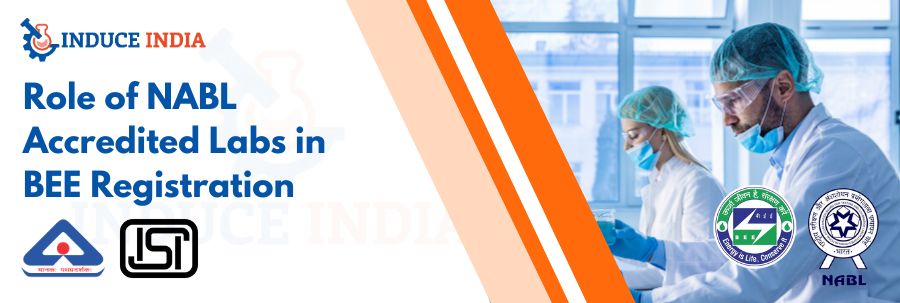As far as energy efficiency in India is concerned, there is only one name that comes to mind, and that is BEE (Bureau of Energy Efficiency). Whenever you purchase any air conditioner, refrigerator or geyser, you may have noticed star labels on it. These labels that have stars on them will make you aware of how much a product is energy-efficient. However, have you ever thought who makes these ratings and checks them? And in that comes the entry of NABL-accredited labs.
This blog will help you know what exactly NABL labs are, what the BEE registration means, and last but not least, how these labs are also involved in a key role in providing BEE registration.
BEE Registration: What is BEE Registration?
Bureau of Energy Efficiency, abbreviated as BEE, is a governmental Agency under the Ministry of Power. It has the responsibility of encouraging power-saving behaviours and ensuring that there exist some minimum standards of energy requirements of appliances and other equipment.
In ensuring the correct information about the use of energy is availed to the consumers, BEE initiated the Standards & Labelling (S&L) Program. With this, manufacturers are required to register their products with BEE and obtain the star rating.
Rated between 1 star (least efficient) and 5 stars (most efficient), these ratings assist the customers in making appliance purchases that will allow them to save power and therefore pay less in bills. However, product testing and verification must be accomplished before getting a product to have a star label. This is where NABL-certified laboratories come in very handy.
What do Accredited Labs do?
NABL is the name of an organisation; the National Accreditation Board for Testing and Calibration Laboratories. It is an independent outfit under the Department for Promotion of Industry and Internal Trade (DPIIT), Government of India.
Simply put, NABL approves testing or calibration labs that are up to the international standards of laboratories. It will be a sign of NABL having certified that lab NABL and therefore their findings are reliable, consistent and accurate.
The standards, such as the ISO/IEC 17025, are used in the NABL accreditation after which the lab is approved to have the infrastructure, technical capacity, trained employees and the quality of procedures practised.
Why is NABL Accreditation Much Necessary to BEE?
You might question: Can the test of the energy performance of products not be performed in any lab? The answer is no, not any lab submits its test reports to BEE. It only accepts reports on the test conducted by labs that are NABL-accredited in terms of the parameters needed by a given product.
Why? Since BEE would like to ensure that:
- The product has undergone tests in a technically sound and standardised environment.
- The data is valid, and it has been generated by calibrated instruments.
- The findings are in line with the international tests.
Thus, NABL accreditation and certification serve as a sieve in that only the serious well well-equipped labs are permitted to carry out the testing of the products with respect to getting them the energy labels. This assists BEE to be transparent, fair and correct in the star rating system.
Role of NABL-accredited Labs in the BEE Registration Process
To discuss the role of Accredited labs according to NABL in the entire process of BEE registration of manufacturers and brands, it would be better to break the process down into stages.
- Product testing
Any manufacturer interested in having a BEE rating ought to start by having the product tested. Such testing must occur in an NABL lab. The lab shall also carry out the particular performance tests as necessary under BEE, which may include:
- Power use in some circumstances
- Cooling/heating operations (AC, geysers, etc.)
- Stand-by power consumption
- Operating efficiency
BEE establishes these parameters based on the specifications of each type of product.
- Test Report issue
After the tests, the lab reports, which are a legal document revealing the product’s performance, are issued.
It is necessary to write in this report the full technical readings, conditions of the environment during the testing process, and the final energy performance.
Test reports given by only the NABL labs are acceptable to BEE. Should a producer upload the report of a non-NABL lab, he/she will not pass because it will delay and even lead to losses.
- BEE Portal submission
The second procedure is to upload these test reports to the BEE registration portal and other documents, such as:
- Brand/model specifications
- Manufacturer registration
- Fee payment
At this point, the BEE backend is also checking whether the test report is by an NABL-accredited lab and the tests covered in it effectively are the ones needed. In case the answer is yes, the file is sent forward to be processed. Otherwise, the registration gets stagnated.
- Authorisation and Documentation.
BEE can perform random checks or third-party checks after submission. At times, re-testing of the product may be done. When this happens, they are again sent to a lab that is accredited by NABL.
This makes the process one that is not manipulated or subject to saying a product is very energy efficient. Therefore, in the initial stages and until the end label, NABL labs are enrolled to work as a testing spine of the complete system of BEE.
Effects on Manufacturers and Consumers
It is not only the product testing done by NABL-accredited labs that is their role. It directly influences:
- For Manufacturers:
- Easy BEE registration devoid of refusals and failures to adhere to delays
- Better brand image because of proper ratings
- Quicker releases of products in the market
- Adherence to government standards, not to receive a penalty or to be de-listed
- For Consumers:
- Proper and confirmed star ratings
- Actual savings on electricity bills
- Certainty on how the product would perform
- Decision-making during purchase
Thus, in a lot of aspects, NABL labs are safeguarding the interests of the consumer as well as the credibility of the manufacturer.
Problems and the Needs of NABL Laboratories
The challenge that many manufacturers have had is that there are not enough NABL-accredited labs, particularly in a specific category or parts of the country.
This tends to cause delay or wait time during testing, higher expenses or product launch delay.
There emerges, therefore, a need:
- Many more labs to be NABL accredited in India
- Routine training and renovation of lab equipment
- Quicker accreditation procedure by NABL to answer the expanding demand
Lab infrastructure has to be developed through government and private sector cooperation, so that India is able to fulfil its energy efficiency targets at a quicker rate.
Conclusion
The labelling of the star on appliances is something that we glance at and sometimes make a decision in seconds. Yet behind such an insignificant label, there is an infrastructure of testing, quality assurance, and extremely detailed processes. Phase to this network is the NABL-accredited labs, the quiet achievers who make sure what is being said is what is tested and proven to be tested.
In the case of manufacturers, it is not possible to get BEE registration without NABL test reports. And consumers would find that star ratings, which have no involvement of NABL, are untrustworthy. India is on the verge of the future of smarter use of energy, and NABL-accredited labs will remain a pivoting block in the same, albeit silently, but steadfastly.



